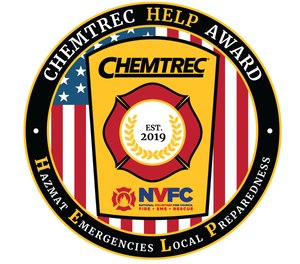
The awards help volunteer fire departments enhance their response capabilities for hazmat incidents
Once again CHEMTREC and the National Volunteer Fire Council (NVFC) are partnering to award financial assistance to volunteer fire departments to help manage hazardous materials emergencies.
As part of CHEMTREC’s 50 th anniversary celebration, a total of $50,000 will be awarded as part of this year’s Hazmat Emergencies Local Preparedness (HELP) Award .
The application period will close on Sept. 1, 2021.
To be eligible to apply for the CHEMTREC HELP Award, departments must meet the following criteria:
On this final point, if the volunteer fire department is incorporated within a city fire department, the volunteer fire department must be a separate 501(c) organization and maintain its finances separately to qualify for the HELP Award. Further, the funding requirement includes all funding the volunteer fire department received, whether it was from the city/county/town budget/tax funding, fundraising, community donations, subscriptions, EMS service/revenue recovery, or other sources. The only exception to exceeding the $250,000 threshold is if the department received a one-time grant in the most recently completed fiscal year that set them over the $250,000 limit. In this case, the department is required to disclose their funding levels for three consecutive preceding years, showing the department’s total income is normally below $250,000 annually.
Note: Only one application will be accepted per department. Any subsequent applications received for that department during the award year will be disqualified. Past recipients of the HELP Award must wait 5 years before reapplying for the award.
Erica Bernstein, CHEMTREC’s director of outreach, offers the following suggestions for potential applicants.
Review all criteria before applying, but pay close attention to a few key items that are sometimes overlooked by applicants, particularly the requirements that the chief or individual applying on behalf of the department is a member of the NVFC and the $250,000 fire department funding limit.
Bernstein also underscores the importance of the narrative part of the application, noting that the award period is open until Sept. 1, which leaves plenty of time to write a detailed narrative (1,000 words or less). Take this opportunity to describe the specific equipment or training that your department needs. What are the estimated costs? Has there been a past incident that demonstrated a gap in training or equipment for your department?
“What has stood out among past recipients of the CHEMTREC HELP Award is in their narrative they painted a picture of their department and demonstrated their department’s need to receive this award,” Bernstein said. “This is your opportunity to tell us your story so that we understand your community, the risks that your department faces, and how the purchase of specific equipment and/or training will increase your department’s capabilities to respond to hazardous material incidents.”
Departments that receive the award must use the money to increase their department’s hazmat response capabilities and not for any other purpose. The award cannot be redistributed.
Additionally, departments that receive the award must agree that their department name, details from their application essay, and all photos taken during the award presentation may be used in media by CHEMTREC, TRANSCAER, American Chemistry Council and the NVFC for the purposes of promoting the award program. The departments that receive the awards also agree to a department visit by CHEMTREC and the NVFC for the award presentation within 60 days of notification of the announcement of the award.
As always, be sure to get an additional set of eyes to review your application before you submit it.
If you have questions about the CHEMTREC HELP Award please contact Bernstein at ebernstein@chemtrec.com or 804-357-4758.
Copyright © 2025 FireGrantsHelp.com. All rights reserved.
